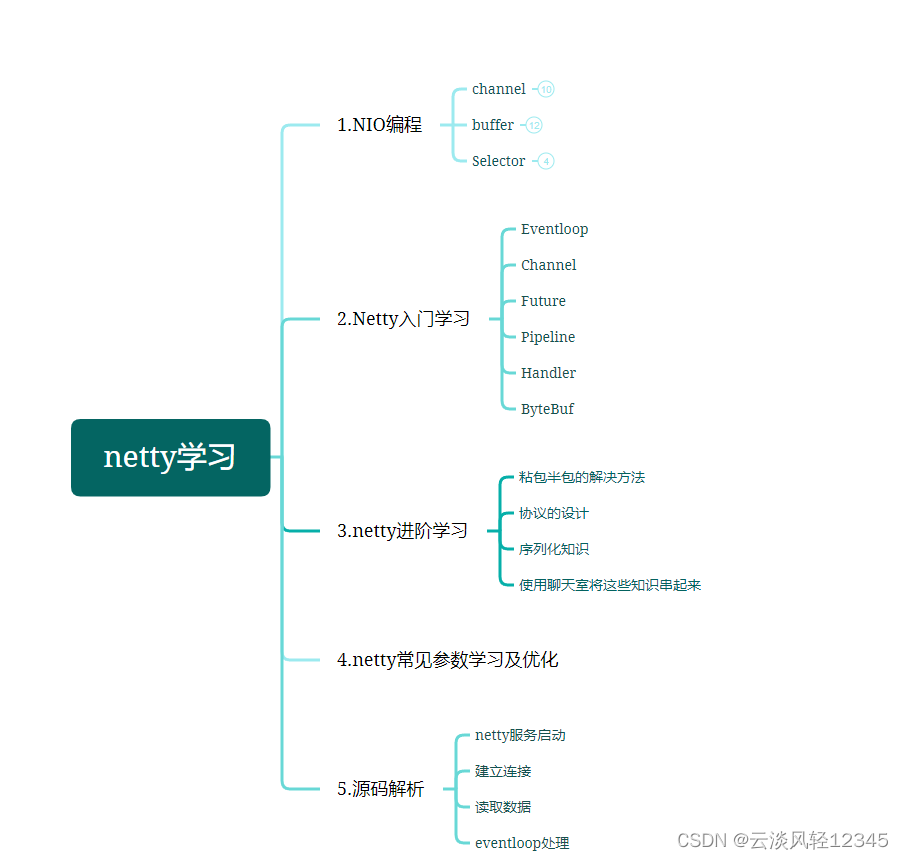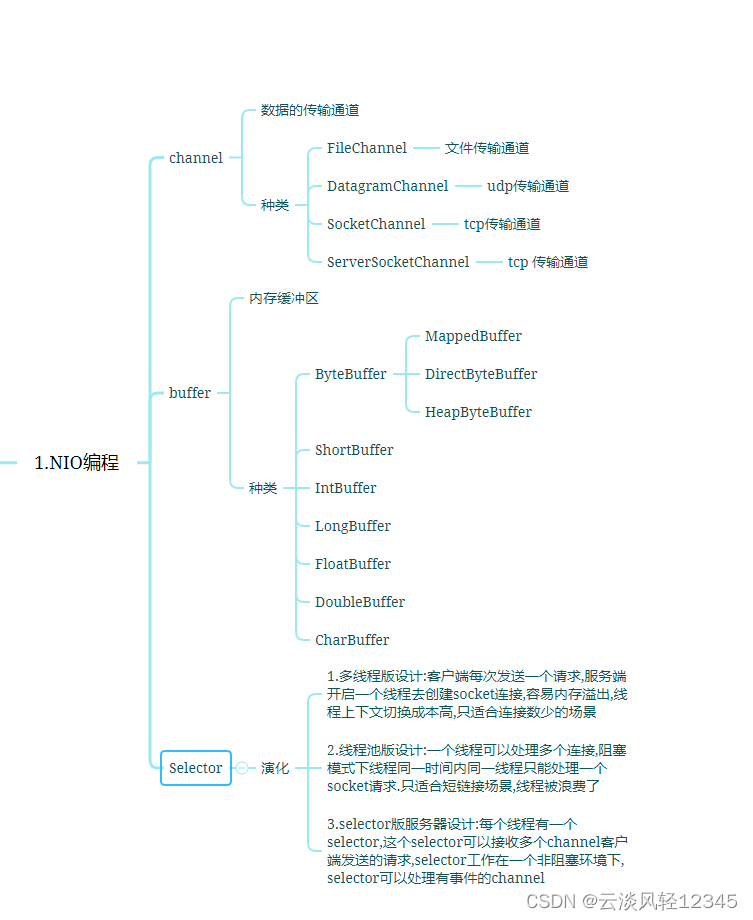1.netty整体知识结构

2.NIO编程

3.ByteBuffer 使用
3.1 构建springboot项目,引入pom文件
<dependency>
<groupId>io.netty</groupId>
<artifactId>netty-all</artifactId>
<version>4.1.39.Final</version>
</dependency>
<dependency>
<groupId>org.projectlombok</groupId>
<artifactId>lombok</artifactId>
<version>1.16.18</version>
</dependency>
<dependency>
<groupId>com.google.code.gson</groupId>
<artifactId>gson</artifactId>
<version>2.8.5</version>
</dependency>
<dependency>
<groupId>com.google.guava</groupId>
<artifactId>guava</artifactId>
<version>19.0</version>
</dependency>
<dependency>
<groupId>ch.qos.logback</groupId>
<artifactId>logback-classic</artifactId>
<version>1.2.3</version>
</dependency>
<dependency>
<groupId>com.google.protobuf</groupId>
<artifactId>protobuf-java</artifactId>
<version>3.11.3</version>
</dependency>3.2 logback的配置文件
<?xml version="1.0" encoding="UTF-8"?>
<configuration
xmlns="http://ch.qos.logback/xml/ns/logback"
xmlns:xsi="http://www.w3.org/2001/XMLSchema-instance"
xsi:schemaLocation="http://ch.qos.logback/xml/ns/logback logback.xsd">
<!-- 输出控制,格式控制-->
<appender name="STDOUT" class="ch.qos.logback.core.ConsoleAppender">
<encoder>
<pattern>%date{HH:mm:ss} [%-5level] [%thread] %logger{17} - %m%n </pattern>
</encoder>
</appender>
<!--<appender name="FILE" class="ch.qos.logback.core.rolling.RollingFileAppender">
<!– 日志文件名称 –>
<file>logFile.log</file>
<rollingPolicy class="ch.qos.logback.core.rolling.TimeBasedRollingPolicy">
<!– 每天产生一个新的日志文件 –>
<fileNamePattern>logFile.%d{yyyy-MM-dd}.log</fileNamePattern>
<!– 保留 15 天的日志 –>
<maxHistory>15</maxHistory>
</rollingPolicy>
<encoder>
<pattern>%date{HH:mm:ss} [%-5level] [%thread] %logger{17} - %m%n </pattern>
</encoder>
</appender>-->
<!-- 用来控制查看那个类的日志内容(对mybatis name 代表命名空间) -->
<logger name="cn.itcast" level="DEBUG" additivity="false">
<appender-ref ref="STDOUT"/>
</logger>
<logger name="io.netty.handler.logging.LoggingHandler" level="DEBUG" additivity="false">
<appender-ref ref="STDOUT"/>
</logger>
<root level="ERROR">
<appender-ref ref="STDOUT"/>
</root>
</configuration>3.3 创建data.txt文件,在项目目录下
123321上山 abc...z
3.4 编写读取代码
package cn.itcast.netty.c1;
import lombok.extern.slf4j.Slf4j;
import java.io.FileInputStream;
import java.io.IOException;
import java.nio.ByteBuffer;
import java.nio.channels.FileChannel;
@Slf4j
public class TestByteBuffer {
public static void main(String[] args) {
//1.FileChannel
//1.输入输出流 2.RandomAccessFile
try (FileChannel channel = new FileInputStream("data.txt").getChannel();) {
//准备缓冲区
ByteBuffer buffer = ByteBuffer.allocate(48);//通过静态方法获得,划分一块内存容量为48个字节
while ( true){
//从Channel读取文件,写到Buffer缓冲区
int read = channel.read(buffer);
if (read == -1){
break;
}
//打印buffer内容
buffer.flip();//将缓冲区转换为开放状态,以便可以将其“阅读”,将缓冲区转化为读模式
while (buffer.hasRemaining()){//当Buffer有内容可用时
byte b = buffer.get();//从缓冲区中取出一个字节,并将其存储到数组中
log.info("读取到的字节:{}",(char)b);//从Buffer中取出1个字符
}
buffer.clear();//将缓冲区转换为可用状态,以便将其“阅读”
}
} catch (IOException e) {
}
}
}
- 向 buffer 写入数据,例如调用 channel.read(buffer)
- 调用 flip() 切换至读模式
- 从 buffer 读取数据,例如调用 buffer.get()
- 调用 clear() 或 compact() 切换至写模式
- 重复 1~4 步骤
3.5 执行结果

写模式下,position 是写入位置,limit 等于容量,下图表示写入了 4 个字节后的状态

flip 动作发生后,position 切换为读取位置,limit 切换为读取限制

读取 4 个字节后,状态

clear 动作发生后,状态

compact 方法,是把未读完的部分向前压缩,然后切换至写模式

5.ByteBuffer 读写模式切换
调试工具类
package cn.itcast.netty.c1;
import io.netty.util.internal.StringUtil;
import java.nio.ByteBuffer;
import static io.netty.util.internal.MathUtil.isOutOfBounds;
import static io.netty.util.internal.StringUtil.NEWLINE;
public class ByteBufferUtil {
private static final char[] BYTE2CHAR = new char[256];
private static final char[] HEXDUMP_TABLE = new char[256 * 4];
private static final String[] HEXPADDING = new String[16];
private static final String[] HEXDUMP_ROWPREFIXES = new String[65536 >>> 4];
private static final String[] BYTE2HEX = new String[256];
private static final String[] BYTEPADDING = new String[16];
static {
final char[] DIGITS = "0123456789abcdef".toCharArray();
for (int i = 0; i < 256; i++) {
HEXDUMP_TABLE[i << 1] = DIGITS[i >>> 4 & 0x0F];
HEXDUMP_TABLE[(i << 1) + 1] = DIGITS[i & 0x0F];
}
int i;
// Generate the lookup table for hex dump paddings
for (i = 0; i < HEXPADDING.length; i++) {
int padding = HEXPADDING.length - i;
StringBuilder buf = new StringBuilder(padding * 3);
for (int j = 0; j < padding; j++) {
buf.append(" ");
}
HEXPADDING[i] = buf.toString();
}
// Generate the lookup table for the start-offset header in each row (up to 64KiB).
for (i = 0; i < HEXDUMP_ROWPREFIXES.length; i++) {
StringBuilder buf = new StringBuilder(12);
buf.append(NEWLINE);
buf.append(Long.toHexString(i << 4 & 0xFFFFFFFFL | 0x100000000L));
buf.setCharAt(buf.length() - 9, '|');
buf.append('|');
HEXDUMP_ROWPREFIXES[i] = buf.toString();
}
// Generate the lookup table for byte-to-hex-dump conversion
for (i = 0; i < BYTE2HEX.length; i++) {
BYTE2HEX[i] = ' ' + StringUtil.byteToHexStringPadded(i);
}
// Generate the lookup table for byte dump paddings
for (i = 0; i < BYTEPADDING.length; i++) {
int padding = BYTEPADDING.length - i;
StringBuilder buf = new StringBuilder(padding);
for (int j = 0; j < padding; j++) {
buf.append(' ');
}
BYTEPADDING[i] = buf.toString();
}
// Generate the lookup table for byte-to-char conversion
for (i = 0; i < BYTE2CHAR.length; i++) {
if (i <= 0x1f || i >= 0x7f) {
BYTE2CHAR[i] = '.';
} else {
BYTE2CHAR[i] = (char) i;
}
}
}
/**
* 打印所有内容
* @param buffer
*/
public static void debugAll(ByteBuffer buffer) {
int oldlimit = buffer.limit();
buffer.limit(buffer.capacity());
StringBuilder origin = new StringBuilder(256);
appendPrettyHexDump(origin, buffer, 0, buffer.capacity());
System.out.println("+--------+-------------------- all ------------------------+----------------+");
System.out.printf("position: [%d], limit: [%d]\n", buffer.position(), oldlimit);
System.out.println(origin);
buffer.limit(oldlimit);
}
/**
* 打印可读取内容
* @param buffer
*/
public static void debugRead(ByteBuffer buffer) {
StringBuilder builder = new StringBuilder(256);
appendPrettyHexDump(builder, buffer, buffer.position(), buffer.limit() - buffer.position());
System.out.println("+--------+-------------------- read -----------------------+----------------+");
System.out.printf("position: [%d], limit: [%d]\n", buffer.position(), buffer.limit());
System.out.println(builder);
}
private static void appendPrettyHexDump(StringBuilder dump, ByteBuffer buf, int offset, int length) {
if (isOutOfBounds(offset, length, buf.capacity())) {
throw new IndexOutOfBoundsException(
"expected: " + "0 <= offset(" + offset + ") <= offset + length(" + length
+ ") <= " + "buf.capacity(" + buf.capacity() + ')');
}
if (length == 0) {
return;
}
dump.append(
" +-------------------------------------------------+" +
NEWLINE + " | 0 1 2 3 4 5 6 7 8 9 a b c d e f |" +
NEWLINE + "+--------+-------------------------------------------------+----------------+");
final int startIndex = offset;
final int fullRows = length >>> 4;
final int remainder = length & 0xF;
// Dump the rows which have 16 bytes.
for (int row = 0; row < fullRows; row++) {
int rowStartIndex = (row << 4) + startIndex;
// Per-row prefix.
appendHexDumpRowPrefix(dump, row, rowStartIndex);
// Hex dump
int rowEndIndex = rowStartIndex + 16;
for (int j = rowStartIndex; j < rowEndIndex; j++) {
dump.append(BYTE2HEX[getUnsignedByte(buf, j)]);
}
dump.append(" |");
// ASCII dump
for (int j = rowStartIndex; j < rowEndIndex; j++) {
dump.append(BYTE2CHAR[getUnsignedByte(buf, j)]);
}
dump.append('|');
}
// Dump the last row which has less than 16 bytes.
if (remainder != 0) {
int rowStartIndex = (fullRows << 4) + startIndex;
appendHexDumpRowPrefix(dump, fullRows, rowStartIndex);
// Hex dump
int rowEndIndex = rowStartIndex + remainder;
for (int j = rowStartIndex; j < rowEndIndex; j++) {
dump.append(BYTE2HEX[getUnsignedByte(buf, j)]);
}
dump.append(HEXPADDING[remainder]);
dump.append(" |");
// Ascii dump
for (int j = rowStartIndex; j < rowEndIndex; j++) {
dump.append(BYTE2CHAR[getUnsignedByte(buf, j)]);
}
dump.append(BYTEPADDING[remainder]);
dump.append('|');
}
dump.append(NEWLINE +
"+--------+-------------------------------------------------+----------------+");
}
private static void appendHexDumpRowPrefix(StringBuilder dump, int row, int rowStartIndex) {
if (row < HEXDUMP_ROWPREFIXES.length) {
dump.append(HEXDUMP_ROWPREFIXES[row]);
} else {
dump.append(NEWLINE);
dump.append(Long.toHexString(rowStartIndex & 0xFFFFFFFFL | 0x100000000L));
dump.setCharAt(dump.length() - 9, '|');
dump.append('|');
}
}
public static short getUnsignedByte(ByteBuffer buffer, int index) {
return (short) (buffer.get(index) & 0xFF);
}
}
调试代码
package cn.itcast.netty.c1;
import java.nio.ByteBuffer;
import static cn.itcast.netty.c1.ByteBufferUtil.debugAll;
public class TestByteBufferReadWrite {
public static void main(String[] args) {
ByteBuffer buffer = ByteBuffer.allocate(10);
buffer.put((byte)0x61);
debugAll(buffer);
buffer.put(new byte[]{(byte)0x62,(byte)0x63,(byte)0x64});
debugAll(buffer);
buffer.flip();
System.out.println( buffer.get());
debugAll(buffer);
buffer.compact();
debugAll(buffer);
buffer.put(new byte[]{(byte)0x65,(byte)0x6f});
debugAll(buffer);
}
}
打印结果
+--------+-------------------- all ------------------------+----------------+
position: [1], limit: [10]
+-------------------------------------------------+
| 0 1 2 3 4 5 6 7 8 9 a b c d e f |
+--------+-------------------------------------------------+----------------+
|00000000| 61 00 00 00 00 00 00 00 00 00 |a......... |
+--------+-------------------------------------------------+----------------+
+--------+-------------------- all ------------------------+----------------+
position: [4], limit: [10]
+-------------------------------------------------+
| 0 1 2 3 4 5 6 7 8 9 a b c d e f |
+--------+-------------------------------------------------+----------------+
|00000000| 61 62 63 64 00 00 00 00 00 00 |abcd...... |
+--------+-------------------------------------------------+----------------+
97
+--------+-------------------- all ------------------------+----------------+
position: [1], limit: [4]
+-------------------------------------------------+
| 0 1 2 3 4 5 6 7 8 9 a b c d e f |
+--------+-------------------------------------------------+----------------+
|00000000| 61 62 63 64 00 00 00 00 00 00 |abcd...... |
+--------+-------------------------------------------------+----------------+
+--------+-------------------- all ------------------------+----------------+
position: [3], limit: [10]
+-------------------------------------------------+
| 0 1 2 3 4 5 6 7 8 9 a b c d e f |
+--------+-------------------------------------------------+----------------+
|00000000| 62 63 64 64 00 00 00 00 00 00 |bcdd...... |
+--------+-------------------------------------------------+----------------+
+--------+-------------------- all ------------------------+----------------+
position: [5], limit: [10]
+-------------------------------------------------+
| 0 1 2 3 4 5 6 7 8 9 a b c d e f |
+--------+-------------------------------------------------+----------------+
|00000000| 62 63 64 65 6f 00 00 00 00 00 |bcdeo..... |
+--------+-------------------------------------------------+----------------+6. ByteBuffer 常见方法
1.分配空间,可以使用 allocate 方法为 ByteBuffer 分配空间,其它 buffer 类也有该方法
Bytebuffer buf = ByteBuffer.allocate(16);2.向 buffer 写入数据
调用channel的read方法
int readBytes = channel.read(buf);调用buffer的put方法
buf.put((byte)127);int writeBytes = channel.write(buf);byte b = buf.get();get 方法会让 position 读指针向后走,如果想重复读取数据
可以调用 rewind 方法将 position 重新置为 0
调用 get(int i) 方法获取索引 i 的内容,它不会移动读指针
package cn.itcast.nio.c2;
import java.nio.ByteBuffer;
public class TestByteBufferAllocate {
public static void main(String[] args) {
System.out.println(ByteBuffer.allocate(16).getClass());
System.out.println(ByteBuffer.allocateDirect(16).getClass());
/*
class java.nio.HeapByteBuffer - java 堆内存,读写效率较低,受到 GC 的影响
class java.nio.DirectByteBuffer - 直接内存,读写效率高(少一次拷贝),不会受 GC 影响,分配的效率低
*/
}
}
8. mark和reset
mark在读取时,做一个标记,即使position改变,只要调用reset就会回到mark地址
注意: rewind和flip都会清楚mark位置
9. 字符串和ByteBuffer相互转换
package cn.itcast.nio.c2;
import java.nio.ByteBuffer;
import java.nio.charset.StandardCharsets;
import static cn.itcast.nio.c2.ByteBufferUtil.debugAll;
public class TestByteBufferString {
public static void main(String[] args) {
// 1. 字符串转为 ByteBuffer
ByteBuffer buffer1 = ByteBuffer.allocate(16);
buffer1.put("hello你好".getBytes());
debugAll(buffer1);
// 2. Charset
ByteBuffer buffer2 = StandardCharsets.UTF_8.encode("hello你好");//输出结果自动转化为读模式
debugAll(buffer2);
// 3. wrap
ByteBuffer buffer3 = ByteBuffer.wrap("hello你好".getBytes());//输出结果自动转化为读模式
debugAll(buffer3);
// 4. 转为字符串
String str1 = StandardCharsets.UTF_8.decode(buffer2).toString();
System.out.println(str1);
buffer1.flip();
String str2 = StandardCharsets.UTF_8.decode(buffer1).toString();
System.out.println(str2);
}
}
10. 分散读和集中写
words.txt
onetwothreepackage cn.itcast.nio.c2;
import java.io.IOException;
import java.io.RandomAccessFile;
import java.nio.ByteBuffer;
import java.nio.channels.FileChannel;
import static cn.itcast.nio.c2.ByteBufferUtil.debugAll;
public class TestScatteringReads {
public static void main(String[] args) {
try (FileChannel channel = new RandomAccessFile("words.txt", "r").getChannel()) {
ByteBuffer b1 = ByteBuffer.allocate(3);
ByteBuffer b2 = ByteBuffer.allocate(3);
ByteBuffer b3 = ByteBuffer.allocate(5);
channel.read(new ByteBuffer[]{b1, b2, b3});
b1.flip();
b2.flip();
b3.flip();
debugAll(b1);
debugAll(b2);
debugAll(b3);
} catch (IOException e) {
}
}
}
package cn.itcast.nio.c2;
import java.io.IOException;
import java.io.RandomAccessFile;
import java.nio.ByteBuffer;
import java.nio.channels.FileChannel;
import java.nio.charset.StandardCharsets;
public class TestGatheringWrites {
public static void main(String[] args) {
ByteBuffer b1 = StandardCharsets.UTF_8.encode("hello");
ByteBuffer b2 = StandardCharsets.UTF_8.encode("world");
ByteBuffer b3 = StandardCharsets.UTF_8.encode("你好");
try (FileChannel channel = new RandomAccessFile("words2.txt", "rw").getChannel()) {
channel.write(new ByteBuffer[]{b1, b2, b3});
} catch (IOException e) {
}
}
}
11. 黏包和半包
package cn.itcast.nio.c2;
import java.nio.ByteBuffer;
import static cn.itcast.nio.c2.ByteBufferUtil.debugAll;
public class TestByteBufferExam {
public static void main(String[] args) {
/*
网络上有多条数据发送给服务端,数据之间使用 \n 进行分隔
但由于某种原因这些数据在接收时,被进行了重新组合,例如原始数据有3条为
Hello,world\n
I'm zhangsan\n
How are you?\n
变成了下面的两个 byteBuffer (黏包,半包)
Hello,world\nI'm zhangsan\nHo
w are you?\n
现在要求你编写程序,将错乱的数据恢复成原始的按 \n 分隔的数据
*/
ByteBuffer source = ByteBuffer.allocate(32);
source.put("Hello,world\nI'm zhangsan\nHo".getBytes());
split(source);
source.put("w are you?\n".getBytes());
split(source);
}
private static void split(ByteBuffer source) {
source.flip();
for (int i = 0; i < source.limit(); i++) {
// 找到一条完整消息
if (source.get(i) == '\n') {
int length = i + 1 - source.position();
// 把这条完整消息存入新的 ByteBuffer
ByteBuffer target = ByteBuffer.allocate(length);
// 从 source 读,向 target 写
for (int j = 0; j < length; j++) {
target.put(source.get());
}
debugAll(target);
}
}
source.compact();
}
}





















 739
739











 被折叠的 条评论
为什么被折叠?
被折叠的 条评论
为什么被折叠?








